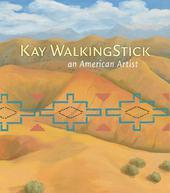
|
Kay Walkingstick: An American Artist
Hardback
Main Details
Description
Kay WalkingStick (Cherokee) is one of the best-known living Native American artists. In her 45-year career in the visual arts, WalkingStick has created iconic paintings featured in numerous exhibitions and publications. In 1995, she became the first Native American and the first Native American woman artist to be included in H. R. Janson's History of Art, an essential art history survey text. Her acclaimed and accomplished career is now being celebrated with the National Museum of the American Indian book and exhibition Kay WalkingStick- An American Artist. This volume includes essays by leading scholars and historians arranged chronologically to guide readers through WalkingStick's life journey and rich artistic career. Much of her early work in the late 1960s and early 1970s experimented with color and the human form; by the mid-1970s, however, she abandoned the figure and began to focus on abstraction and the influence of her Native identity. During this time WalkingStick began to draw upon historical Native American subjects including Chief Joseph and Sacagawea. In the mid-1980s, she began using the diptych format, two-panel works juxtaposing realistic and abstracted views of landscapes. After suffering a devastating personal loss early in this time, her art became more volatile, dark, and intense. In recent decades she has merged her many interests--in landscapes, in the body--to create truly transcendent and powerful works. This book also explores themes of motherhood, sexuality, and Christianity, promoting a broader appreciation for and understanding of WalkingStick's art.
Author Biography
KATHLEEN ASH-MILBY is an associate curator at the Smithsonian National Museum of the American Indian in New York. A member of the Navajo Nation, she organized numerous contemporary art exhibitions and received the 2011 Secretary of the Smithsonian's Excellence in Research Award for her exhibition catalogue, HIDE- Skin as Material and Metaphor. DAVID PENNEY, an internationally recognized scholar of American Indian art, is the associate director of museum scholarship at the Smithsonian's National Museum of the American Indian. He recently published Before and After the Horizon- Anishinaabe Artists of the Great Lakes.
ReviewsPUBLISHERS WEEKLY This sumptuously designed and richly detailed catalogue, a companion to WalkingStick's forthcoming exhibition at the National Museum of the American Indian, capably provides a comprehensive retrospective on Native American painter WalkingStick's abundant career while confirming her rightful inclusion in the canon of American art. In the introduction, curator Ash-Milby (Hide: Skin as Material and Metaphor) and scholar Penney (Before and After the Horizon) laud WalkingStick as "probably the best known and most celebrated artist of Native American ancestry working today," while lamenting the fact that so little of the public actually knows much about current Native art. WalkingStick is of Scottish and Irish lineage on her mother's side and Cherokee on her father's, and the complexities of dual identity serve as the book's compelling through-line. Many of the essays touch on different aspects of the same issues, allowing the reader to accumulate insights from a multitude of angles. She is presented here as "Feminist, and not. Modern, postmodern, and not. Native, and not." The lush reproductions of WalkingStick's artwork are, of course, the highlight. Of particular note are the iconic Chief Joseph series, the diptychs, and the Talking Leaves series. (Nov.)
|